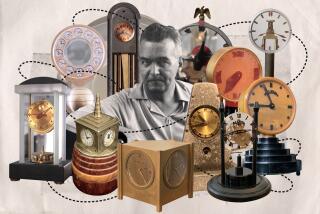Time’s Right for Family Clock Business
NATIONAL CITY — If it is true that it is unfair to judge a book by its cover, then it follows that a business should not be judged by its facade. For proof, one need not look any further than the the Gazo Family Clock Factory, located in a pointedly nondescript row of modern warehouses in this city’s industrial zone.
From the outside, there is nothing to separate the Gazo family’s business from the scores of other manufacturing firms that have sprung up on West 25th Street. But inside, the Gazos and about 20 craftsmen working for them design and build intricate--and expensive--clocks that are renowned throughout the country and sold even in Switzerland and Germany, long regarded as the clock-making capitals of the world.
In charge of the factory, and intimately involved in all of its facets, is 36-year-old Ed Gazo, who took it over from his parents in the late ‘70’s. Gazo began working in the factory in 1974, after completing a stint in the Air Force, and sister, Renee, and wife, Andrea, followed suit shortly thereafter.
“Makers of Beautiful Clocks for Generations to Come,” is the business motto, and underscores the family’s pride in their work.
“There is a lot of pride invested here,” Gazo says as he leads a visitor on a tour through the factory. “From the very beginning, we design our clocks as a family, and it’s a constant guessing game trying to determine what is going to sell out there. Our final designs are based on what we think the true clock-lover wants. We’re always looking to create something new, something that has not been seen on the market before.”
While the designs are original, each of the 13 models of Gazo clocks and two music boxes are handcrafted in styles that are decidedly traditional. “We found there was nobody in this country designing new clocks resembling the antique, carved European clocks, and we saw a need among our clientele for that,” Gazo said.
That realization came as the Gazos made the transition from restoring and refinishing antique clocks, which was the original motivation for starting the business in 1964. “It got to the point where we just couldn’t find the parts we needed,” Gazo said. “We started making the parts, and then it got to the point where we figured it would be easier, more profitable and more rewarding creatively to design new clocks ourselves.”
By 1980, the business was booming, and the Gazos had designed 24 clock models. More than 60 employees toiled at the National City plant, and considerable work was handled by a subcontractor at a factory in Tijuana.
“We were doing lots of business, but the special, family feeling of creating only special designs just wasn’t there,” Gazo recalled. “With the recession in the early ‘80s, business dropped some, so we decided to scale things back and do only the work that was important to us.”
Eventually, the family decided to scale back to 13 models, and the cutback in production was accompanied, Gazo said, by enhanced quality. Today, Gazo clocks, many of them named for California communities--Coronado, Rancho Santa Fe, Palo Alto, Monterey--sell for anywhere from $1,300 to $12,200 at 400 small specialty shops throughout the country and in Europe.
The production process begins in the Black Forest region of Germany, where Gazo personally chooses the mechanisms that run the clocks. Some of the clock chimes are enhanced by music boxes purchased in Switzerland, which melodiously play Schubert’s “Ave Maria” or “March of the Toy Soldiers” on the hour.
After the Gazo family has agreed upon a design, the wood casings, often made of oak or walnut, are carved, sanded and finished by hand. Gazo himself no longer performs the quality control function because, “I’d never pass anything, and that would be totally unrealistic.” But each clock is carefully checked and tested for up to a month before it is packed and mailed to the seller.
Gazo is the first to admit that “these clocks don’t appeal to most people--it takes a true collector to make this kind of investment. But that doesn’t mean all of our buyers are rich--many of them rent their homes and drive used cars, but are fascinated by high-quality workmanship. Whatever their income, we appeal to the true clock lover. And those are the people we are proud to be able to satisfy.”
More to Read
Inside the business of entertainment
The Wide Shot brings you news, analysis and insights on everything from streaming wars to production — and what it all means for the future.
You may occasionally receive promotional content from the Los Angeles Times.










